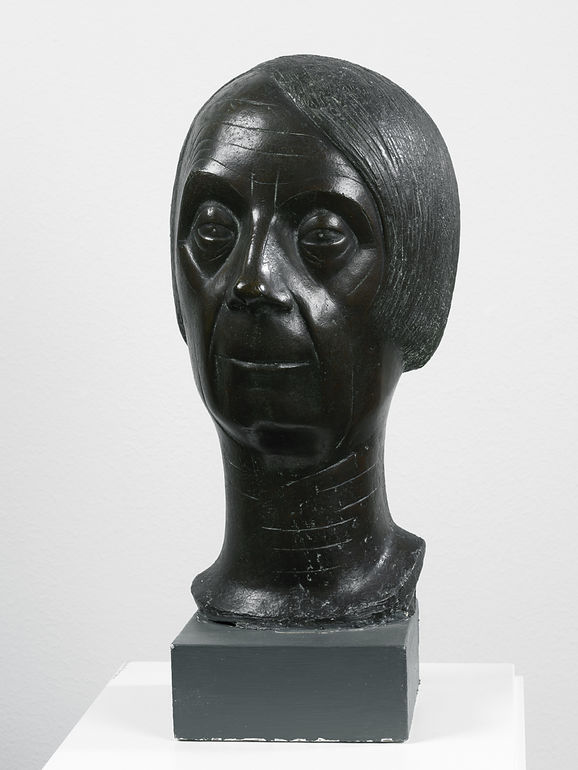The Emy Roeder Estate

In the 1920s, the sculptress was able to establish herself in the art capital of Berlin. Together with Käthe Kollwitz, Renée Sintenis and Milly Steger, she dared to advance in an art world dominated by male artists.
Emy Roeder was born in Würzburg in 1890 as the daughter of an old-established merchant family. In 1908, as a student of Arthur Schleglmünig, she began drawing and modelling in clay at the Polytechnischer Zentralverein Würzburg. Shortly after the early death of her father, she moved to Munich in 1911. From 1913 she studied with the well-known sculptor Bernhard Hoetger and together with him worked on the decoration of the sycamore grove in Darmstadt. From him she gained her modern understanding of sculpture, which concentrated on tectonics, form and the right and honest approach to the material being used.
In 1914/15, the young artist moved to Berlin, where she married the sculptor Herbert Garbe and in 1919 established herself there permanently. In Berlin Emy Roeder not only experienced the companionship of artists of her own generation, but also encountered the work of groundbreaking sculptors like Alexander Archipenko, Ernst Barlach and Wilhelm Lehmbruck. As a member of the “Novembergruppe” (“November Group”), she socialized with artists of Die Brücke, like the expressionists Erich Heckel and Karl Schmidt-Rottluff, and became acquainted with Käthe Kollwitz, Milly Steger, Rudolf Belling and Ewald Mataré among others.
In those days, she discovered an expressionistic use of forms for her sculptural work. “The Pregnant Woman” and “Boy Praying” in the Museum im Kulturspeicher are two rare wooden sculptures from this short expressionistic phase. Many other works from this period were either destroyed or vanished without a trace.
In 1920, Emy Roeder continued her studies in the master-class of the sculptor Hugo Lederer at the Academy of Arts in Berlin, which by that time was open to women. In the years to come, she not only formed outstanding busts, but also group sculptures expressing the human and natural bond. Intimacy and devotion characterize the mother-and-child relationship both in these works and in her sculptural portrayals of female friends and siblings.
In 1937, after early successes in Berlin, exhibitions and distinctions, her terracotta sculpture “Pregnant Woman” was vilified and exhibited as “degenerate art” by the National Socialists. From 1936 until her internment in Padova, Emy Roeder lived in Florence, initially as a fellow of the Villa Romana. Here she was able to work politically undisturbed and live secluded life.
She returned to Germany from Rome in 1949/50. Aged almost sixty and with the help of Fritz Vollbach in Mainz, she was able to establish a new existence. Toward the end of her life, she was a close friend of the sculptors Hans Mettel, Wilhelm Loth and Gustav Seitz. Until her death, Emy Roeder lived and worked in Mainz but kept in touch with Würzburg, even though she no longer had any family connections in Würzburg.
Emy Roeder lived to see two World Wars, devastation, reconstruction and a generational shift; however, she always remained in contact with the contemporary art scene. In the 1950s she received considerable recognition with the sculptured portraits of her painter friends Erich Heckel, Hans Purrmann and Karl Schmidt-Rottluff. In 1955 she was featured at the documenta I in Kassel. At the beginning of the 1960s, encounters with women of Tripolitania in Northern Africa inspired her to make extremely reduced, larger than life-sized portrayals of women.
Although Emy Roeder never returned to Würzburg, while still alive she bequeathed her entire artistic estate to her native city. The municipal collection not only contains her own sculptures and drawings but also works by her artist friends. The Museum im Kulturspeicher is in charge of her estate and has installed a permanent exhibition space solely for her works.
Her estate contains about 70 sculptures and plaster models, more than 100 drawings, letters, and works by her artist friends, such as Erich Heckel, Hans Purrmann, Karl Schmidt-Rottluff and Gustav Seitz.
Emy Roeder erlebte zwei Weltkriege, Zerstörung, Wiederaufbau und den Wechsel der Generationen mit, doch verlor sie nie den Bezug zur Gegenwartskunst. Mit den ausdrucksstarken Bildnisköpfen ihrer Malerfreunde Erich Heckel, Hans Purrmann und Karl Schmidt-Rottluff erfuhr sie in den 1950er Jahren höchste Anerkennung: 1955 war sie auf der documenta I in Kassel vertreten. Zu Beginn der 1960er Jahre inspirierte sie die Begegnung mit den Tripolitanerinnen in Nordafrika zu äußerst reduzierten, auch überlebensgroß ausgeführten Frauendarstellungen.
Obgleich Emy Roeder nicht mehr nach Würzburg zurückkehrte, vermachte sie noch zu Lebzeiten ihrer Heimatstadt ihren künstlerischen Nachlass, der nicht nur ihre eigenen Skulpturen und Zeichnungen, sondern auch Werke befreundeter Künstler enthält. Das Museum im Kulturspeicher Würzburg betreut und verwahrt ihren Nachlass und hat ihr dauerhaft einen eigenen Ausstellungsraum eingerichtet.
Ihr Nachlass umfasst rund 70 Skulpturen und Gipsmodelle sowie über 100 Zeichnungen, dazu Briefe und Werke der mit ihr befreundeten Künstler, u.a. Erich Heckel, Hans Purrmann, Karl Schmidt-Rottluff und Gustav Seitz.
>>> back
